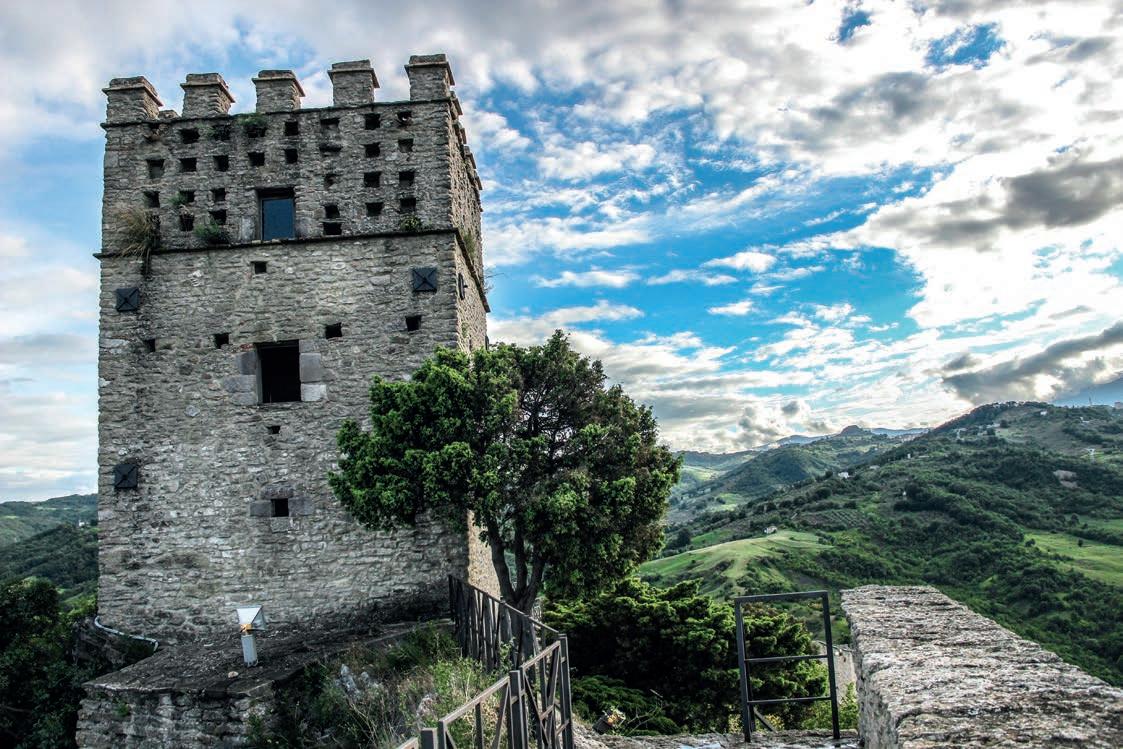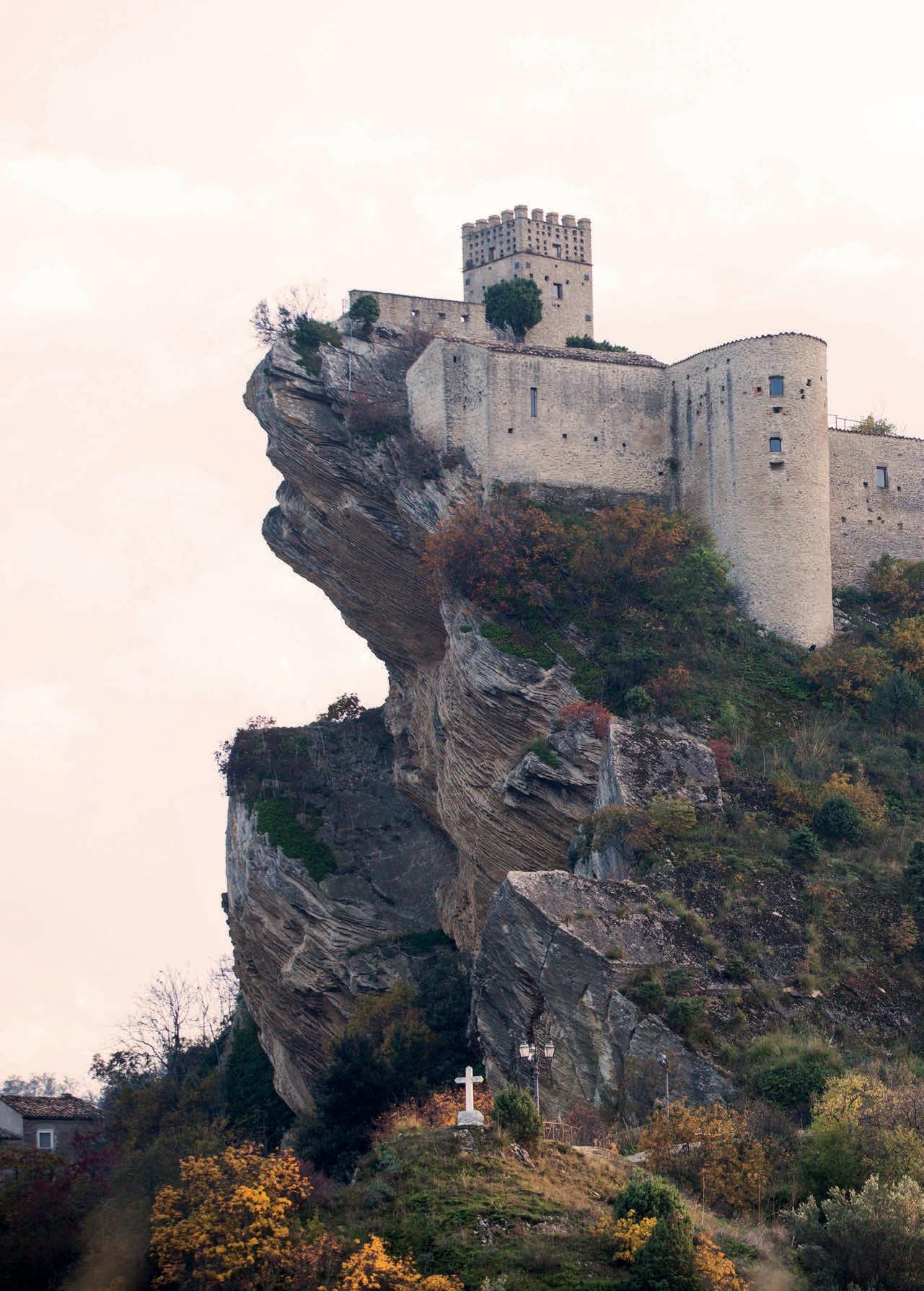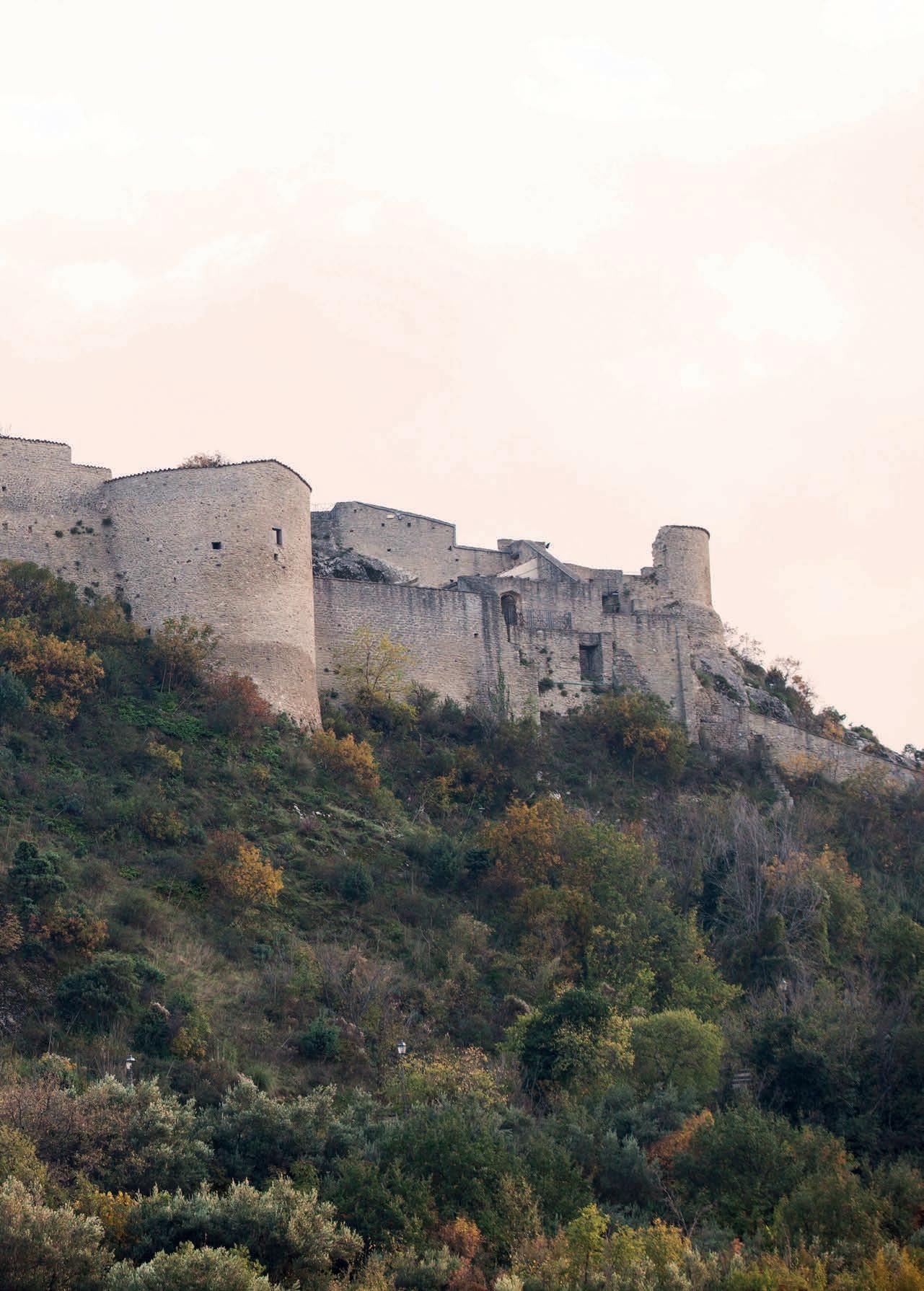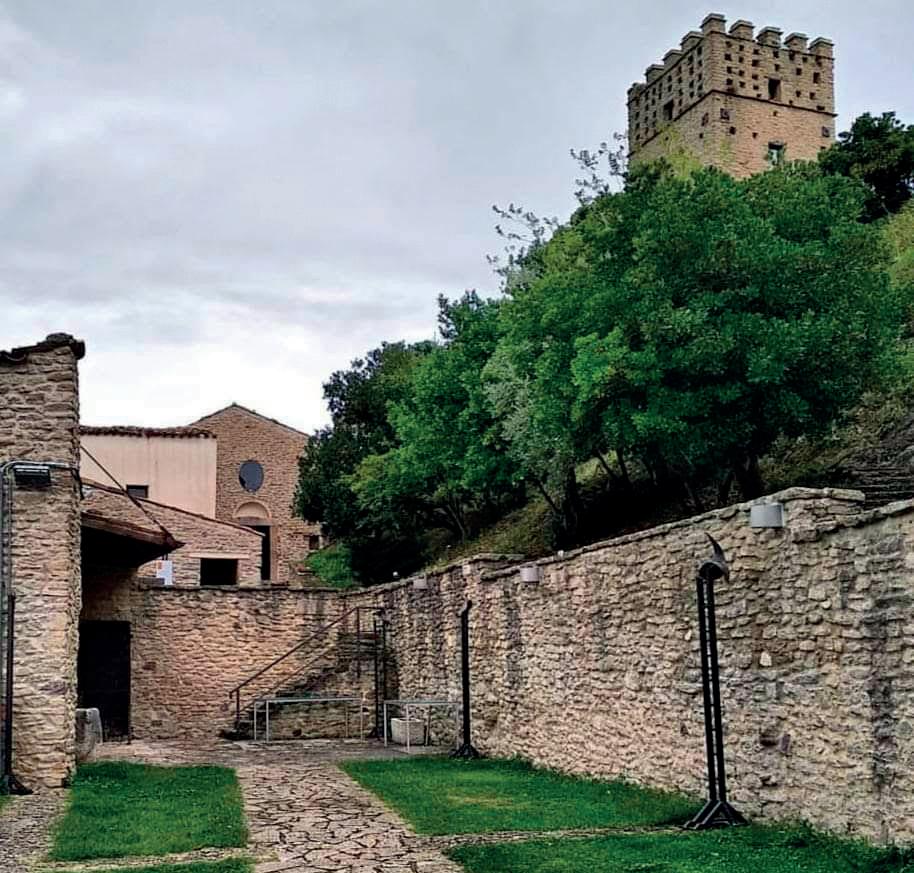
12 minute read
Bellezza e mito, Roccascalegna è un set cinematografico Beauty and myth, Roccascalegna is a film set
Bellezza e mito, Roccascalegna è un set cinematografico
Beauty and myth, Roccascalegna is a film set
Advertisement
Carmen Di Giovannangelo
Roccascalegna è un comune del Chietino di 1.200 anime, adagiato nella valle del Rio Secco. Il piccolo borgo, a mezz’ora di macchina da Fara San Martino, negli ultimi anni è salito alla ribalta delle cronache nazionali ed internazionali, grazie alla CNN che gli ha dedicato un meraviglioso servizio per la possibilità di affittarlo come sede di matrimoni, ed al regista Matteo Garrone, che lo ha scelto per l’ambientazione di parte del suo film, “Il racconto dei racconti”, con Vincent Cassel e Salma Hayek. Lo scorso anno, inoltre, nella fortezza sono state girate alcune scene di esterni della serie tv della Rai “Il nome della Rosa.” Scenario di videoclip musicali (Pico Rama ed Emilia Di Pasquale), visitato da personaggi noti che lo scelgono per le loro passeggiate domenicali, castello e borgo di Roccascalegna (grazie anche ai numerosi servizi tv di “Alle Falde del Kilimangiaro”, “Italia delle Meraviglie”, “Sereno Variabile”, “Linea Verde”, ecc), sono diventati un passaggio obbligato per tutti coloro che scelgono l’Abruzzo come meta delle loro vacanze o delle loro uscite fuori porta. Questa estate il Castello è stata scelto come una delle immagini della campagna di promozione nazionale dell’Ente Turismo della Regione Abruzzo.
Tra storia e leggenda
La parte antica di questo angolo d’Abruzzo si sviluppa ai piedi della roccia calcarea alla cui sommità svetta l’imponente castello, esistente già nel XII sec.
Il primo proprietario del Castello di Roccascalegna fu Annichino de Annichinis, soldato di ventura, giunto in Abruzzo al seguito del feudatario Giacomo Caldora, che gli regalò il feudo di Roccascalegna Roccascalegna is a municipality in the province of Chieti of 1200 people, lying in the Rio Secco valley.
The small village, a half-hour drive from Fara San Martino, in recent years has risen to the forefront of national and international news thanks to the CNN, that dedicated to it a wonderful report for the possibility to rent it as a set for weddings, and thanks to the director Matteo Garrone, who chose it for the setting of his film “Il racconto dei racconti” (“The tale of tales”), with Vincent Cassel and Salma Hayek. Moreover, last year in the fortress, some exterior scenes of the Italian RAI TV series “Il nome della rosa” (“The name of the rose”) were shot. Scenery of music videos (Pico Rama and Emilia Di Pasquale), visited by famous people who choose it for their Sunday walks, the castle and the village of Roccascalegna (also thanks to the numerous TV reports of the Italian TV programmes “Alle falde del Kilimangiaro”, “Italia delle meraviglie”, “Sereno Variabile”, “Linea Verde”, etc) have become an essential stop for all those who choose the Abruzzo region as a destination for their holidays or for their outdoors trips. This summer the castle has been chosen as one of the images of the national tourism campaign of the Abruzzo Region Tourist Board. Between history and legend
The ancient part of this corner of Abruzzo develops at the foot of the limestone rock at the top of which stands the impressive castle, which already existed in the 12th century. The first owner of the castle of Roccascalegna was Annichino de Annichinis, a soldier of fortune, who came in Abruzzo leaded by the feudatory
come riconoscenza per i servigi resigli. Gli succedettero Raimondo, Alfonso e Giovanni Maria che si macchiò di diverse colpe, tra cui l’assassinio di un nobile, la complicità con i francesi, l’odio nei confronti del re Carlo V e la sua stretta relazione con i feudatari Riccio di Lanciano, eventi che, nel 1528, gli fecero perdere sia il titolo nobiliare, sia il feudo, che passò nelle mani dei Carafa di Napoli. Questi, a loro volta, lo persero allorché il barone Orazio, in seguito all’applicazione di “leggi ingiuste e lesive”, fu trucidato dagli abitanti di Roccascalegna nel 1584.
Così il feudo tornò nelle mani del Regio Demanio per essere poi comprato dalla famiglia De Corvis di Sulmona che, nel 1599, per mano del barone Vincenzo Corvi, lo acquistò per diecimila ducati.
Alla famiglia de Corvis è legata la leggenda dello jus primae noctis”, ovvero “il diritto della prima notte”: chi si sposava in paese doveva “doveva pagare una tassa stabilita dal signore del castello, e chi non poteva permetterselo doveva cedere la propria sposa per una notte al barone. Questa legge determinò la scomunica del barone Corvo de Corvis da parte del sacerdote della vicina chiesa di San Pietro. Lo stesso religioso incitò la folla a ribellarsi al tiranno, che reagì invianGiacomo Caldora, who gave him the feud of Roccascalegna as appreciation for the services he rendered him. He was succeeded by Raimondo, Alfonso and Giovanni Maria, who was guilty of several faults, among which the murder of a nobleman, the complicity with the French, the hatred towards King Charles V and his strong relationship with the Riccio feudal lords from Lanciano, events that in 1528 made him lose both the title of nobility and the feud, which passed into the hands of the Carafa family from Naples. These, in their turn, lost it when Baron Orazio, after the application of “injust and harmful laws”, was slaughtered by the inhabitants of Roccascalegna in 1584.
Thus the feud returned to the hands of the royal estate and then was bought by the De Corvis family from Sulmona that, in 1599, at the hands of Baron Vincenzo Corvi, bought it for 10,000 ducats.
The De Corvis family is linked to the “jus primae noctis” legend, that is “the right of the first night”: those who got married in the village had to pay a fee established by the Lord of the castle, and those who could not afford it had to leave their bride to the Baron for one night.This law determined the excommunication of Baron Corvo De Corvis by the priest of
GRANDI FILM E PROGRAMMI TV
CI HANNO GIRATO IL NOME DELLA ROSA E IL RACCONTO DEI RACCONTI SUL PICCOLO SCHERMO CON ITALIA DELLE MERAVIGLIE, SERENO VARIABILE, LINEA VERDE E ALLE FALDE DEL KILIMANGIARO


GREAT FILMS AND TV PROGRAMMES
“THE NAME OF THE ROSE” AND THE “TALE OF TALES” WERE SHOT HERE ON THE SMALL SCREEN WITH “ITALIA DELLE MERAVIGLIE”, “SERENO VARIABILE”, “LINEA VERDE” AND “ALLE FALDE DEL KILIMANGIARO”
do i suoi sgherri a intimidire il prete, che fu sorpreso mentre cercava di mettersi in salvo e trucidato ai piedi del castello stesso. La leggenda narra che un giorno si presentassero dal barone due giovani che volevano sposarsi, ma senza i soldi per adempiere allo “Ius primae noctis”. La sposa fu quindi ceduta al barone per la notte, e fu proprio lei, o forse il suo fidanzato in abiti nunziali, ad assassinare il barone pugnalandolo nel talamo e gettandone il corpo giù dalla rupe. Il barone de Corvis, morente, poggiò una mano insanguinata sul muro prima di cadere giù, e la leggenda vuole che in epoche diverse si provasse più volte a cancellare la “mano di sangue”, ma che essa riaffiorasse sempre, finché nel 1940 parte del castello crollò, forse per le forti piogge o forse per una scossa di terremoto, portandosi via anche la camera dove avvenne l’omicidio.
Si successero poi a capo del feudo Annibale, Giuseppe, Giovanni Battista ed Annibale III de Corvis. Il feudo finì quindi nelle mani di Pompeo, ed infine Pompeo Filippo lo vendette a un aristocratico di Palena, don Nicolò Nanni.
I Nanni, imparentati con i Croce (famiglia che diede i natali al filosofo e statista Benedetto) acquistarono il feudo nella prima metà del 1700, ma in breve tempo lo abbandonarono e chiusero, preferendo vivere in un palazzo sito al centro del paese, oggi adibito ad abitazione privata, di cui ben poco resta delle antiche vestigia baronali. I Croce-Nanni, come gli altri signori del castello, ebbero un atteggiamento autoritario nei confronti dei loro sudditi.
Durante il periodo del brigantaggio il maniero, oramai decadente, fu sede della Guardia Nazionale e durante le due guerre mondiali divenne rifugio di ogni sorta di sbandati e malfattori. Rimase proprietà dei Croce-Nanni fino al 1980, quando fu donato al Comune di Roccascalegna. I lavori di restauro iniziarono solo nell’aprile 1993 e la maestosa opera di restauro durò oltre 3 anni. Dalla sua riapertura, nell’agosto del 1996, il castello è adibito a spazio museale, sede di spettacoli musicali e presentazioni di libri, e, negli ultimi anni, sede meravigliosa di matrimoni civili.
Il maniero, che sovrasta il borgo antico ed il paese nuovo, si raggiunge alla fine di una gradonata scavata nella roccia risalente al 1600, alla cui sommità vi sono i resti di un ponte levatoio che serviva come attraversamento del fossato antistante, oltre che ulteriore difesa del castello. Varcato il portone d’ingresso ci si trova su un grande cortile al cui lato sinistro si ammirano i resti della torre crollata. Di fronte, entrando, c’è la torre di sentinella, poi la torre quadrata, quindi la cappella dedicata al Santo Rosario, la torre Angioina, il magazzino, la torre del Carcere e le segrete.
Meritano una visita passando per il paese anche la Chiesa di San Pietro (XVI secolo), collocata ai piedi del Castello, e l’antica abazia di San Pancrazio (XII the near Church of San Pietro. The same religious encouraged the crowd to rebel against the tyrant, who reacted by sending his henchmen to intimidate the priest, who was surprised while he was trying to save himself and killed at the foot of the castle. Legend has it that one day two young people visited the Baron because they wanted to get married, but didn’t have the money to fulfill the “Ius primae noctis”. The bride was then given to the Baron for the night. It was her, or perhaps her boyfriend in wedding dresses, who murdered the Baron by stabbing him in the thalamus and throwing his body down the cliff. Baron De Corvis, dying, put a bloody hand on the wall before falling down, and legend has it that in different times, it was tried several times to delete the “hand of blood”, but that it always resurfaced, until in 1940 part of the castle collapsed, perhaps due to the heavy rain or perhaps for an earthquake, taking away also the room where the murder took place.
Then, Annibale, Giuseppe, Giovanni Battista and Annibale III De Corvis succeeded in charge of the feud. The feud then ended in the hands of Pompeo, and finally Pompeo Filippo sold it to an aristocrat from Palena, don Nicolò Nanni.
The Nanni family, related to the Croce one (the family that gave birth to the philosopher and statesman Benedetto) bought the feud in the first half of the 18th century, but in a short time they abandoned and closed it, preferring to live in a palace located in the centre of the village, today used as a private residence, of which very little remains of the ancient baronial vestiges. The Croce-Nanni family, as the other Lords of the castle, had an authoritarian attitude towards their subjects.
During the brigandage period the manor house, by then in decline, was the headquarters of the National Guard, and during the two world words it became a shelter for all sorts of degenerates and wrongdoers. It remained the property of the Croce-Nanni family until 1980, when it was donated to the municipality of Roccascalegna. The majestic restoration work began only in April 1993 and it lasted over three years. Since its reopening, in August 1996, the castle has been used as a museum, as a location for musical performances and book presentations and, in recent years, as a wonderful venue for civil weddings.
The manor house, which overlooks the old and the new village, can be reached at the end of a flight step carved into the rock dating back at 1600, at the top of which there are the remains of a drawbridge that served to cross the front moat, and that was a further defence for the castle. Once crossed the entrance door you find yourself on a large courtyard, to the left of which you can admire the remains of the collapsed tower. While coming into it, on the opposite side, it
secolo), sita a circa due chilometri dal paese, nei pressi del cimitero. Da oltre dieci anni la struttura museale, di proprietà del Comune di Roccascalegna, è gestita dalla locale Proloco che, impiegando quasi esclusivamente volontari locali, si occupa di effettuare il servizio di biglietteria, accompagnare i gruppi prenotati, effettuare pulizia e manutenzione ordinaria della stessa, allestire mostre ed organizzare eventi, il cui culmine si ha, da alcuni anni, nella giornata di Pasquetta, quando l’intero paese si anima con spettacoli di falconieri, armigeri medievali, giocolieri e burattinai.
Nel 2020 giungerà alla XXIV il Roccascalegna in Festival, importante rassegna di musica classica, folk e cantautorale, anch’essa organizzata, da alcuni anni a questa parte, dalla Proloco, che negli anni ha visto succedersi sul palco artisti di fama mondiale, quali Eugenio Finardi, Gianmaria Testa, Riccardo Tesi, Cisco, Kelly Joyce, Bobo Rondelli e Dente. S is possible to see the sentinel tower, then the square tower, then the chapel dedicated to “Santo Rosario”, the Angevin tower, the warehouse, the prison tower and the dungeons. Passing through the village, also the church of San Pietro (16th century), located at the foot of the castle, and the ancient abbey of San Pancrazio (12th century), located at about 2 km far from the village, near the cemetery, are worth a visit. For more than 10 years the museum, owned by the municipality of Roccascalegna, has been managed by the local Pro Loco that, employing almost exclusively local volunteers, deals with making the ticketing service, accompanying the groups booked, making the cleaning and the routine maintenance of the same, setting up exhibition and organising events, whose peak has been, for some years, on Easter Monday, when the whole village becomes animated with performances of falconers, medieval weapons carriers, jugglers, and puppeteers.
In 2020 the 24th edition of the “Roccascalegna in Festival” is coming, an important fair of classical, folk and songwriting music, also organised by the Pro Loco, which over the years has hosted international famous artists such as Eugenio Finardi, Gianmaria Testa, Riccardo Tesi, Cisco, Kelly Joyce, Bobo Rondelli and Dente. S











